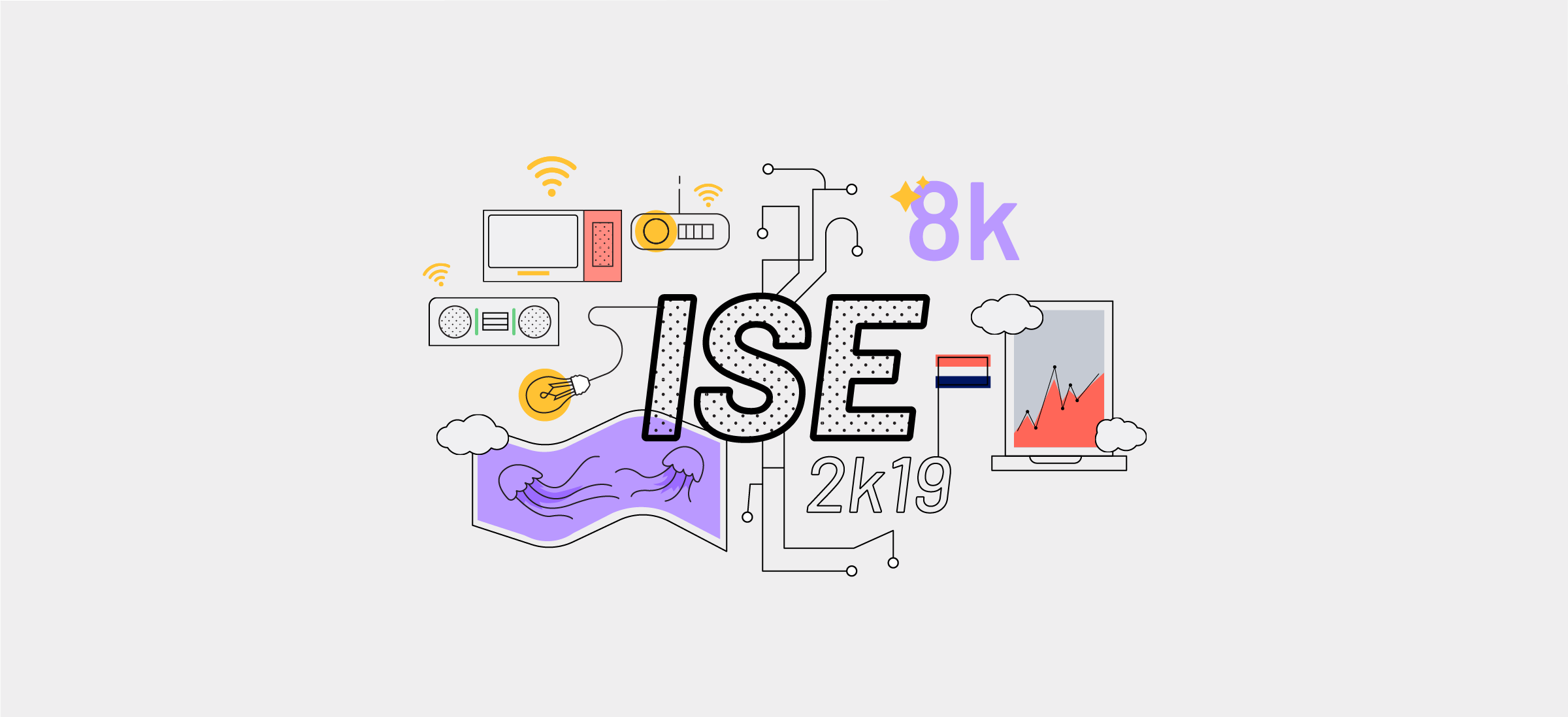We trawled all the exhibitions at ISE 2019 to find the decision-making technology trends that will have a prominent impact on 2019 …
Technology trends: What we saw at ISE 2019

Last week, I went to Integrated Systems Europe 2019 in Amsterdam with a bunch of my skilled colleagues. Integrated Systems Europe or ISE is the melting pot of all things AV, from panel discussions and expert opinions to product launches and event showstoppers. Check out this article on how it went for us.
I had the opportunity to browse the many exhibitors that made up the show while I was there. It was a tech wonderland filled to the brim with eye-catching and beautiful content, and I was equally impressed and intrigued by the unique products and experiences on display.
Here are some of the technology trends that piqued my interest.
8k and video walls: a visual sugar rush
The first thing anyone will probably mention after visiting ISE is the visual explosion that happens when you enter any hall. The whole event was awash with engaging and untraditional displays, such as Ledeca’s giant head-shaped LED display, Sony’s CrystalLED showing stunning 8k content on a display of 9.7 x 5.4 meters (a diagonal of about 440’’, folks!) or LG’s transparent OLED signage screens and their rollable OLED TVs.
The entire LED industry is unquestionably focusing on more and better pixels, and it was an impressive show of force from some of the industry’s titans. But while big screens and more pixels really stole the show at larger exhibitors such as Sony and LG, they didn’t portray anything majorly new or innovative.

I personally thought the 8k content and video walls were more about the ‘cool factor’ than actual usability. What I did take away from these larger exhibitors was the interesting fact that screens are no longer static objects, but can morph into all shapes and sizes, making signage and immersive experiences a lot better.
Digital signage is (still) all the rage
80% of brands experienced an increase of up to 33% in sales using digital signage, just like visual aids improve classroom learning by up to a staggering 400%, and 52% of travelers are more likely to go to a hotel that offers self-check-in, while quick service restaurants report a 30% increase in order value when customers use smart vending.
These rosy figures, reported by the official newspaper of Integrated Systems Europe, The Daily, indicated that growth in the digital signage sector is still on the rise; much more than other industries could hope for.
Because there’s such a rapid evolution going on with size and pixelation in video walls, digital signage can capture the audience way better than before. 8k video walls with IPS (Insane Performance Rendering) makes it possible to drive 8k video walls or clusters of four 4k digital signage displays from a single media player, which is quite something.

Digital signage setups are now able to summarize how many people walked by the displays, looked at the signage, for how long – and then add to that personal data about the user/consumer such as personal identification traits like age, gender or habits. In response to that data, messages can be modified in real-time.
Personal data out the window
It’s quite eerie to see how the use of data has changed. Digital signage can only become this sophisticated because we’re giving away more personal data than ever before.
And why is that? It’s a changing consumer behavior born by younger generations brought up with social media. They’ve been taught to share their data and use it for their benefit, and it’s having a massive impact on what we can convince an audience to do because the message becomes so tailored and specific.

Yes, it could mean a better overall experience with tech tools, digital signage, and IoT, but at what cost? I find it a little scary that the next standard for offices, for example, could be having my face on file as an entrance key or other types of logins. But maybe I’ll change my mind when I see how seamlessly it can make things work for the better.
Standardization
What I generally heard a lot of people say at ISE was that the demand for standardization is high. Users want to enjoy a consistent experience with a simplified design, and preferably one that has a solid standard for implementation as well.
Too many solutions are overcomplicated or require skills beyond what the regular user has. It’s time for tech companies, AV solutions especially, to take a step down from their ivory tower and into the user’s shoes.
Essentially, it’s function over form: if the solution can’t carry out the function it’s supposed to because someone had aesthetic or other things top of mind instead of what’s needed, it’s bound to cause confusion and disappointment.
Unfortunately, I heard the demand for more standardization rather than saw it at the show. It’s a pity, but at least when users are being vocal about their wishes, companies will have to follow suit eventually.
The downfall of projection
LED screens are making a move to steal the limelight from traditional projection. Eventually, they could be a complete replacement in both cinemas and classrooms where they are most widely used.
The average cinema-goer in Europe only spends about five hours in a cinema each year, according to analysts IHS market, and in order to attract more people, cinemas are trying to upgrade the total experience, making it more immersive and of higher quality.

Taking projectors out from classrooms has to do with tearing down walls. A projector binds students to a specific area or classroom whereas screens can be moved around more freely, allowing teachers more freedom and a more dynamic style of teaching.
Immersive technology explosion
It’s time for the physical and digital experience to fuse, ISE 2019 seems to tell us. Virtual sommeliers in restaurants, in-store scavenger hunts, digital garment collections. It opens up to a whole new world of business opportunities when you add digital content to the real world.
We’re talking holography to guide you through the consumer/user experience, mixed reality glasses, and gamification mixed with VR. And when you add AI to all of these immersive experiences, the user will be truly engaged with the content presented.

What was missing?
ISE 2019 was basically all the tech giants flexing their muscles. The show-off of the latest cutting-edge technology from all exhibitors, large and small, was engaging and entertaining, yet there were definitely a few things missing.
The 8k content was mesmerizing, but more of an initial sugar rush than something tangible that the user could take away from the exhibition. I think Airtame was a good antidote for all the wow effect booths at ISE, giving attendees a product with actual daily usability.
I wish ISE had a bigger focus on sustainability as well. The long halls were filled to the brim with eye-catching and amazing AV wonders, but I didn’t see a ‘green mindset’ presented in all that.
I did read a small post in The Daily about unboxing, though. With bulkier roll-outs, organizations could reduce disposal significantly by buying from companies that deliver everyday products, such as cables, in bulk. It cuts down on waste and eliminates hours spent on unboxing.
I also think user-friendliness deserve to play a bigger part in the show. We tried hard to make a booth that was different and had the user in mind, and it attracted a lot of attention because other exhibitors had a more conservative approach to their product presentation.
Next year, perhaps more will follow suit. ISE 2019 taught us that we need to see eye to eye with our users in order to better understand their needs, and talking to so many of them last week emphasized the point that they should be the center of attention, not us.